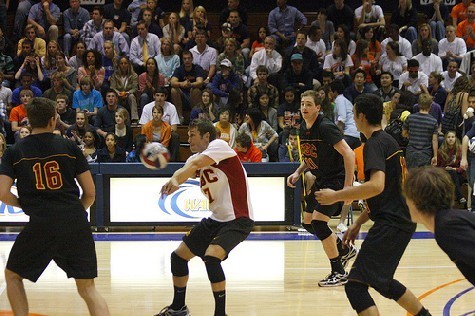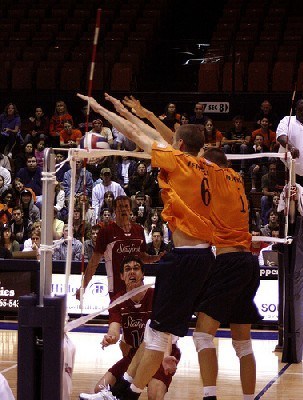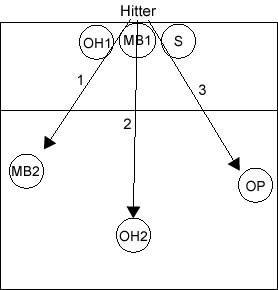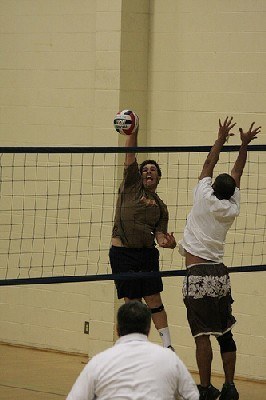Serving techniques are more important now than ever now that scoring is in a rally point format. Why? A bad serve now costs you a point. Let’s dive into how to serve effectively and the strategies to use.
I am going to use the overhand serve method as this is one of the most popular and the easiest to teach from. I am also going to explain this as if you are right-handed.
Feet
Your feet should be shoulder width apart from each other. Since we are discussing this as being right-handed, your right foot will be slightly back from the left and the left foot will be in front. Before actually serving, your body weight should be on your right foot.
Hands
The most common way of explaining serving techniques is the “bow and arrow” method. Imagine that you are shooting a bow and arrow. Your left hand would be holding the bow, and your right hand would pull the string back to fire. The left hand/arm would be straight in front of you, with the right hand/arm by your right ear.
Serving in volleyball is a very similar technique. The ball will be resting in your left hand with your right hand pulled back by your right ear. This is the proper technique and position.
Tossing the Ball
The left hand is going to toss the ball in the air. Many people will argue over how high to toss it. I tell people high enough for you to take a step with your left foot, swing at the ball, and transfer your weight from the right foot to the left foot. You don’t need to rush to do those motions, but you don’t need to toss the ball to the ceiling. Do what is comfortable and makes sense for you.
While the Ball is in the Air
Here is a good photo of what it should look like after the swing:
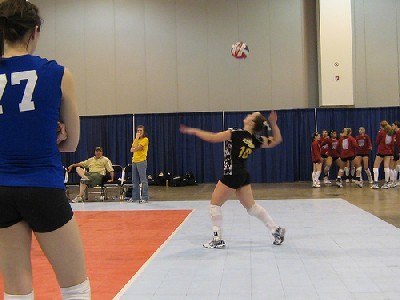
As the image shows, she took a step with her left foot, shifted her body weight from the back foot to the front foot as she stepped, and hit the ball in the same motion. The ball should hit in the center of your hand with the majority of the ball being impacted by the palm of your hand.
Practice serving using the bow and arrow method. The main idea is to get your body prepared to hit, toss the ball, step, and hit. This will make serving easy for you.
There are different types of serves that can be done based on how the ball is struck. Here are some examples:
Topspin Serve
A topspin serve is where the ball is struck so that the ball is spinning towards the direction it is hit. A spin like this will make the ball dive and hit the floor. For people that are serving hard, this is a must so that the ball stays in bounds.
The serving technique for the topspin serve is the same as described above. The main difference is what is done with the hand/wrist at the point of impact on the ball. For the topspin serve, the wrist is snapped forward as the ball is struck. The motion is very similar to how your wrist would snap forward when throwing a ball.
This motion will put the topspin on the ball and you will notice it dive as it is crossing the net.
Floater Serve
A floater serve is a serve where there isn’t any spin on the ball and so it floats and can move in the air unpredictably. Because of the ball movement in the air, it can be difficult for the other team to pass.
To do a floater serve, keep your wrist firm as you are striking the ball. The less your fingers touch the ball, the better your results will be with this. At the moment of impact on the ball, do not snap your wrist or follow-through. It will almost be as if you are slapping the ball since you are not following through.
Jump Serve
The jump serve is a high level serving technique. This one is going to take quite a bit of practice to achieve a level of mastery.

This is just like a back row attack. The serving player will stand several feet behind the back boundary line. They will toss the ball in the air, take their three step approach, and jump (behind the line) and strike the ball at the height of their jump.
When hitting the ball, it is critical to snap your wrist on impact of the ball for maximum torque and maximum spin. This spin is what is going to make the ball dive and land in bounds. If you don’t do this, the ball will likely sail long.
Here is a picture of a jump serve:
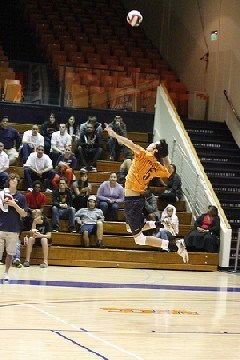
The main point is that this is going to take you some time to get the fluid motion down. Practice the pieces of this: the toss, the approach, and hitting the ball in the air. This is one of the most difficult serving techniques to master, but the rewards are worth it. A good jump serve is a valuable weapon and can be difficult to return.
These serving techniques can help you improve your serving game and get some easy points.

